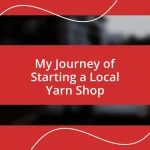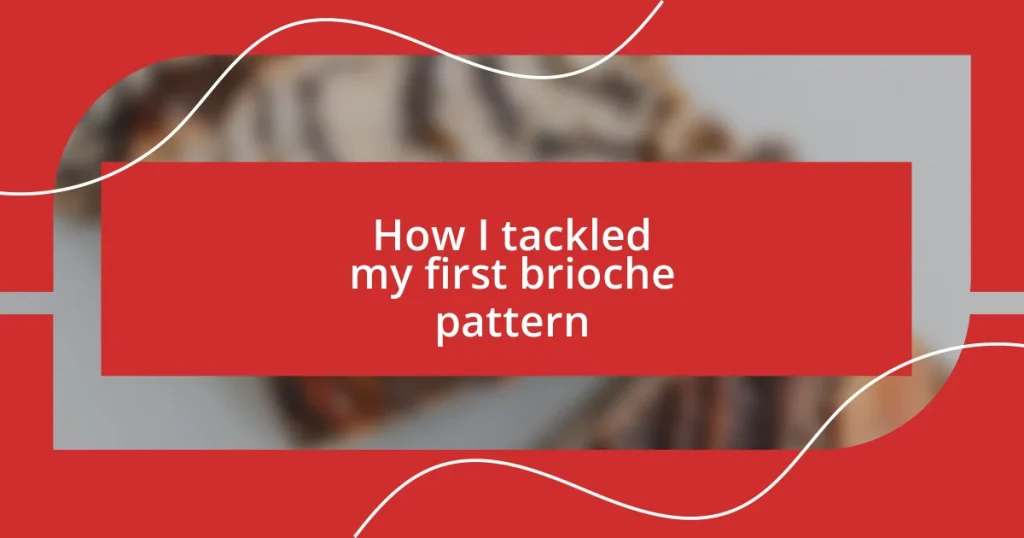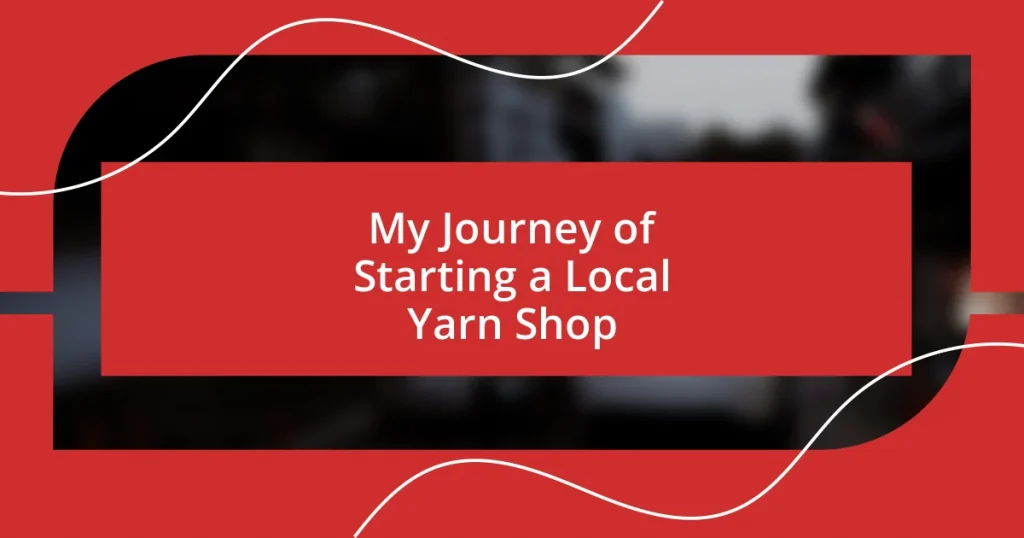Key takeaways:
- Choosing the right yarn (blend of wool and nylon, worsted weight, contrasting colors) significantly impacts brioche knitting results.
- Mastering brioche basics (two-color method, yarn overs, and pattern reading) is essential for creating its unique texture and overcoming initial challenges.
- Patience, practice with swatches, and careful counting are crucial for successful brioche knitting, enabling confidence and reducing mistakes.
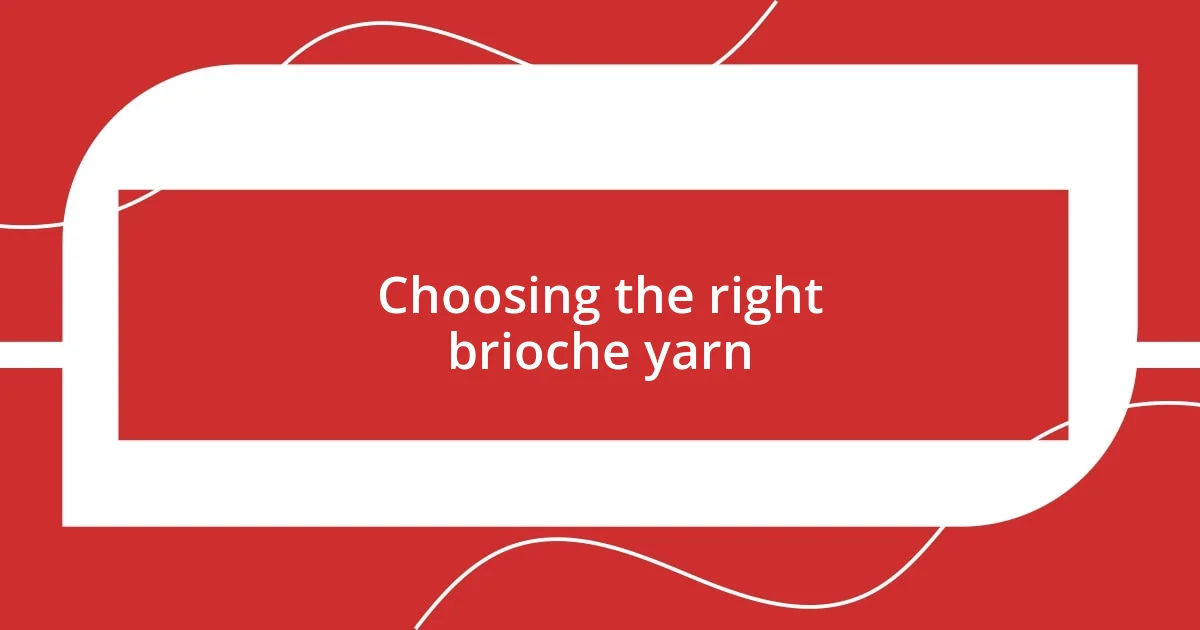
Choosing the right brioche yarn
When it came to choosing the right yarn for my first brioche project, I realized that fiber content matters greatly. I found that a blend of wool and nylon was perfect; the wool provided warmth and elasticity, while the nylon added durability. Isn’t it amazing how a simple choice can influence the entire outcome of a project?
As I browsed through countless yarns, the weight was another deciding factor for me. Opting for a worsted weight made the process much smoother, allowing the stitches to pop and making the pattern more visible. Have you ever struggled with a challenging stitch because the yarn was just too fine? I know I have, and it often led to frustration rather than the joy of creativity.
Lastly, I learned that color plays a pivotal role in brioche knitting. I chose a highly contrasting color combination, which truly highlighted the unique texture of the brioche stitch. Watching the colors blend and shift was a delightful surprise that kept me motivated. Have you picked colors that left you in awe? It’s those small details that make knitting feel truly magical!
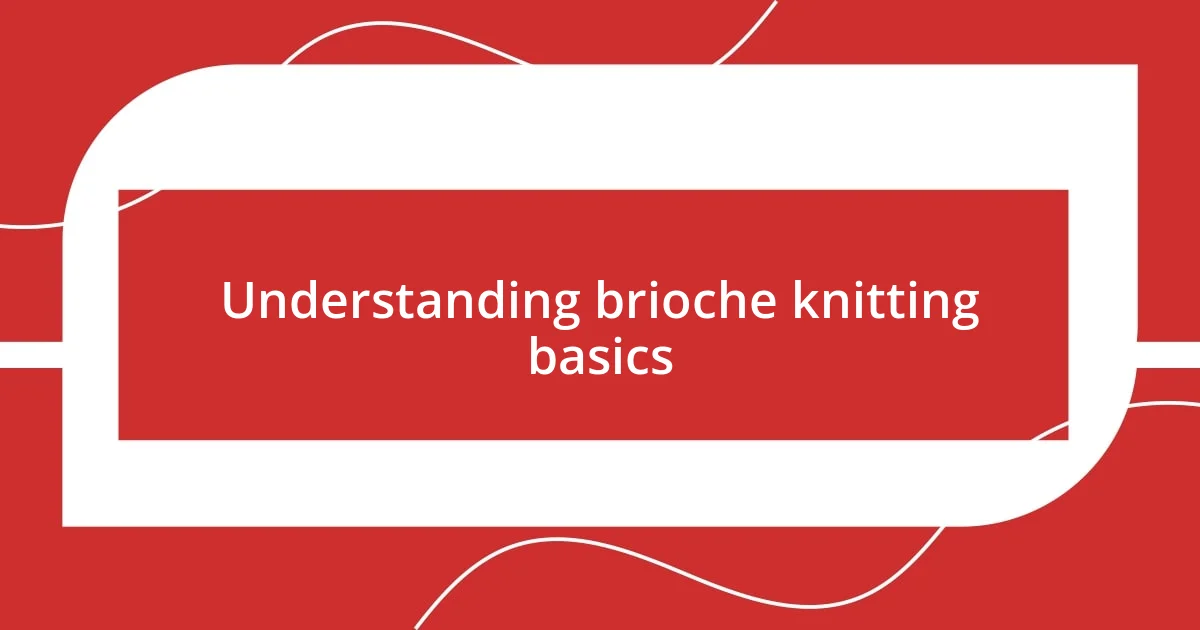
Understanding brioche knitting basics
To dive into brioche knitting, you’ll want to grasp the essential techniques. I remember feeling a mix of excitement and intimidation when I first learned about the brioche stitch. The key lies in understanding the basic two-color methodology, whereby you work with two yarns, alternating between the two to create that signature squishy texture. Once I got the hang of it, I felt like a magician, transforming simple yarn into beautiful fabric.
What truly sets brioche apart is its unique structure. Unlike traditional knitting, brioche creates a thick, lofty fabric that appears almost three-dimensional. My first goal was to master the yarn overs and knit-togethers, which can feel tricky at first. However, I’ll tell you that this is where the charm lies; with persistence, those initial struggles evolve into a satisfying rhythm that leaves you eager for more.
Understanding how to read brioche patterns is another crucial aspect. Many patterns may seem daunting with their abbreviations and notations. I recall pulling out my hair over my first chart, yet I quickly discovered that once I understood the symbols, the knitting flowed beautifully. Familiarizing myself with the shorthand makes learning new stitches feel like a friendly conversation rather than a headache.
| Brioche Technique | Description |
|---|---|
| Two-color method | Alternates between two yarns to create depth and texture |
| Yarn overs | Essential for creating the brioche stitch, allowing for a thicker fabric |
| Reading patterns | Symbols and shorthand indicate specific brioche actions |

Preparing your tools and workspace
Preparing your knitting tools and workspace for brioche can significantly influence your experience. When I embarked on my first brioche project, I quickly realized that having a comfortable and organized environment was essential. I remember setting up my knitting corner with soft lighting and a cozy chair, which made long knitting sessions much more enjoyable. The right tools make a world of difference too; they can turn potential frustration into joy.
Here’s what I found helpful to have on hand:
– Yarn: Select the right weights and colors for your brioche pattern.
– Needles: Circular needles worked wonders for holding all my stitches and gave me better control.
– Stitch markers: These became my best friends, helping me keep track of color changes and pattern repeats.
– Row counter: I used a simple app on my phone; it saved me from losing my place mid-pattern.
– Notepad and pen: Jotting down personal notes and thoughts during the process helped me reflect on what I learned.
Having the right tools not only made knitting easier, it turned my workspace into a creative sanctuary. Each element contributed to making the experience both organized and enjoyable, reminding me why I fell in love with knitting in the first place.
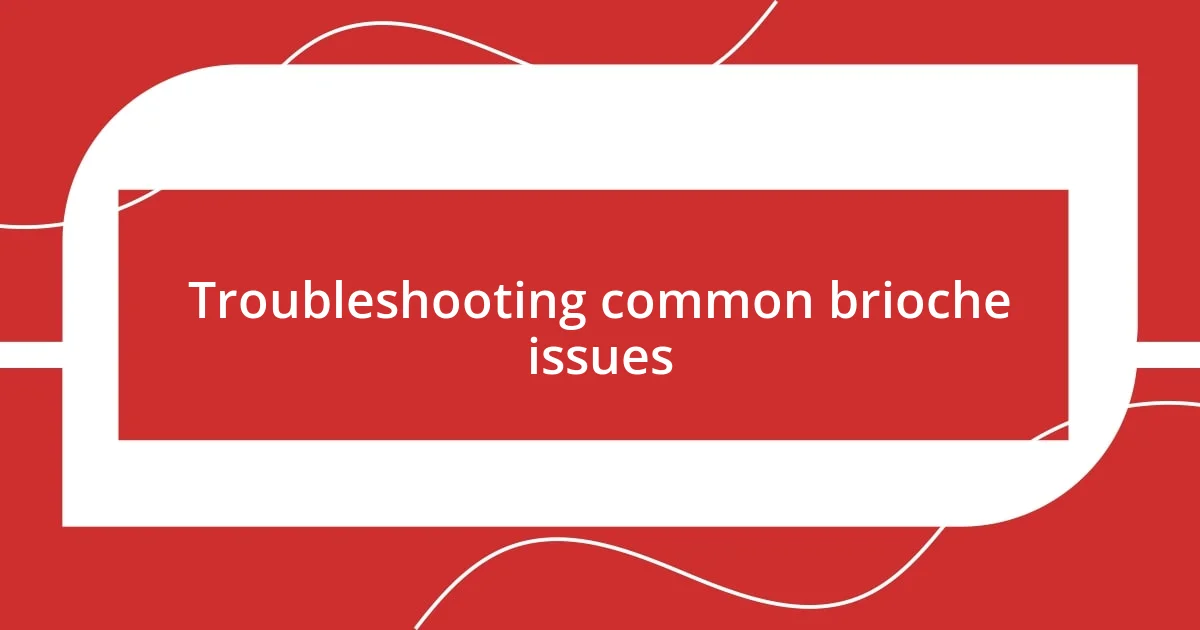
Troubleshooting common brioche issues
Once I got into brioche, I learned that tension is crucial. Have you ever noticed a wobbly edge on your work? I certainly did, and it often stemmed from my yarn being too tight or too loose. Finding that sweet spot made a world of difference, and I felt a genuine sense of accomplishment when I finally achieved an even, consistent fabric. It’s a delicate balance, but experimenting with how tightly or loosely I held my yarn helped transform my project.
Mistakes happen to the best of us, especially in brioche where one misstep can unravel rows of effort. I vividly recall a moment of panic when I discovered a misplaced stitch halfway through a scarf. It felt overwhelming, but I approached it step by step. I learned to frog (rip out) my work carefully, retracing my stitches with patience. Have you ever stopped to appreciate how much you can learn from those little hiccups? They truly became enlightening moments that strengthened my skills and confidence.
Another common issue is the infamous brioche “bump” – those little stitches that seem to pop up unexpectedly. My first encounter left me frustrated and searching for solutions. It turned out that I had been forgetting to yarn over correctly. Realizing that helped me recognize the importance of intentionality in my stitching. Each stitch should feel deliberate, feeding into that rich texture brioche is known for. So, next time you face something similar, just remember: a gentle adjustment can redefine your entire project!
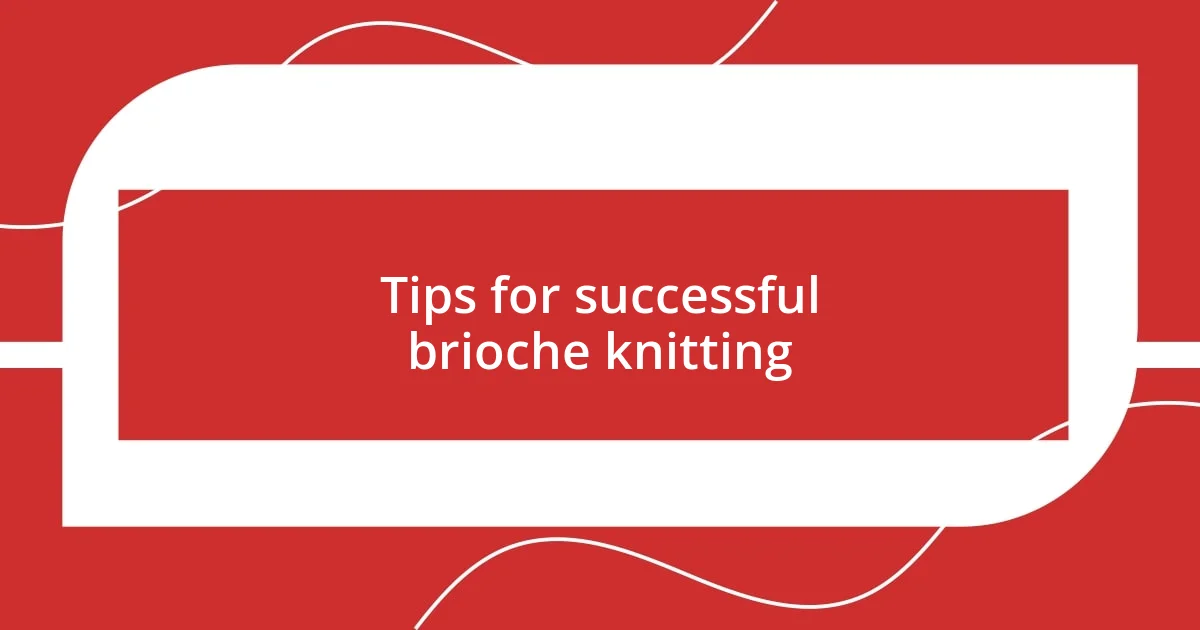
Tips for successful brioche knitting
When I first tackled brioche knitting, I quickly learned that patience is key. I vividly remember sitting in my favorite armchair, surrounded by my supplies, only to realize that understanding the pattern’s rhythm took time. Have you ever found yourself impatiently rushing through a project, only to backtrack because you missed a crucial stitch? Trust me, taking a moment to breathe and focus on each row can transform your entire approach.
One of my best tips is to practice on a smaller swatch before diving into a larger piece. It was a game-changer for me! I spent a rainy afternoon creating test pieces, and each one felt like a mini victory. Did you know that making swatches not only boosts your skill but also builds confidence? Plus, you’ll get to experiment with color combinations and stitch techniques without the pressure of ruining a significant project.
Lastly, stay mindful of your counting with every brioche stitch. I recall an afternoon spent unraveling what felt like an eternity of work because I miscounted my rows. It’s those moments that teach resilience and reinforce the importance of consistency. Using a row counter made a tremendous difference for me, and I think you’ll find it helps you avoid the dreaded chaos of unknitting. Embrace each stitch like it tells a story; it’s all part of the process, after all!
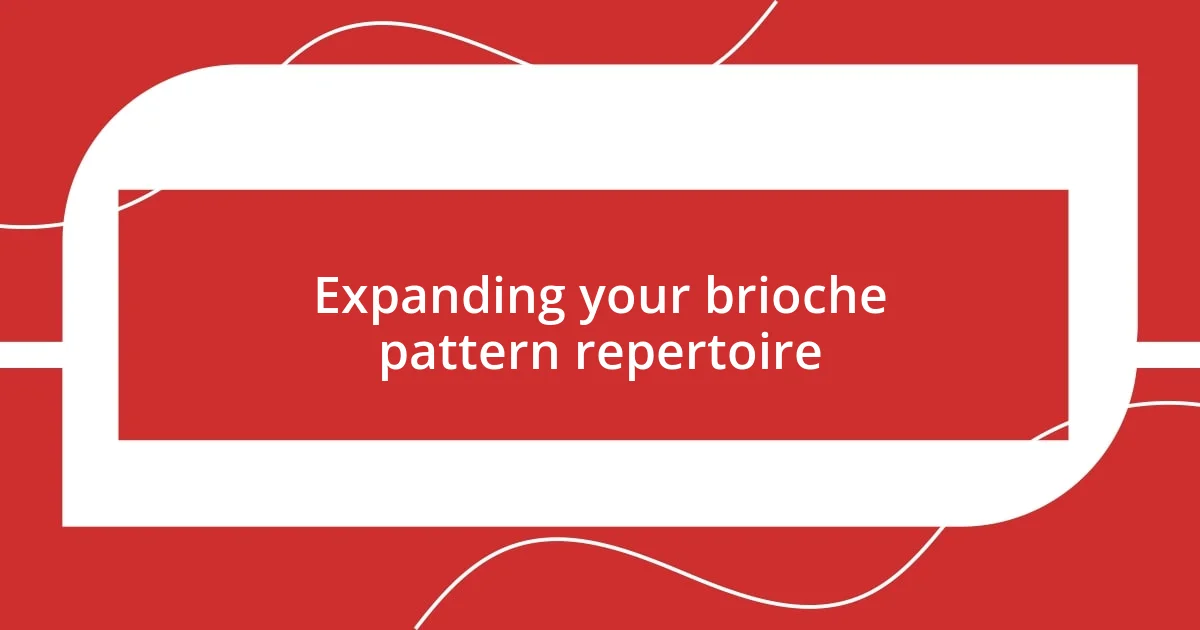
Expanding your brioche pattern repertoire
Expanding my brioche pattern repertoire opened up a world of creativity. I fondly remember the first time I tried a two-color brioche pattern. The thrill of watching those contrasting shades intertwine was exhilarating! Have you experienced that moment when a simple stitch turns into a vibrant visual? It’s like painting with yarn; every row adds depth and dimension to your project.
As I explored more patterns, I stumbled upon the concept of brioche increases and decreases. Initially, I felt overwhelmed, but I decided to experiment. I chose a simple increase technique for my next project, and the results blew me away—my fabric transformed into an elegant design. It’s fascinating how each variation can radically change the texture and appearance of your work. Isn’t it inspiring to realize how a little technique can lead to endless possibilities?
I even found joy in experimenting with stitch patterns on small projects, such as headbands and dishcloths. This low-stakes approach allowed me to play with designs without the pressure of committing to a larger piece. One evening, as I used a new lace stitch in a headband, I remember feeling a wave of excitement when I saw the intricate details emerge. In those moments, I discovered that expanding my brioche skills was not just about mastering techniques, but also about enjoying the journey and celebrating every small victory along the way.
